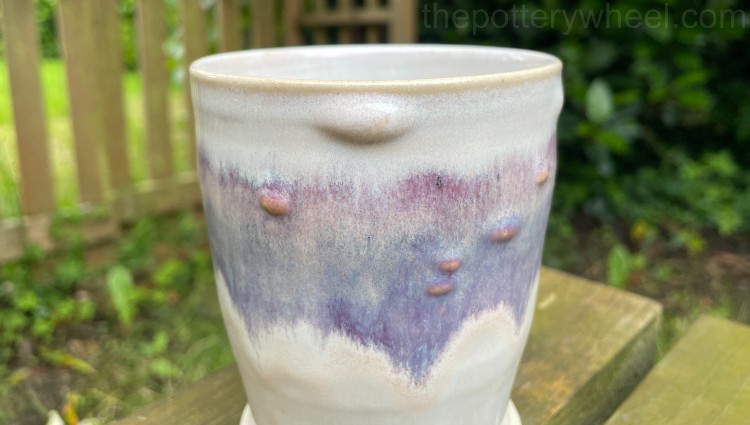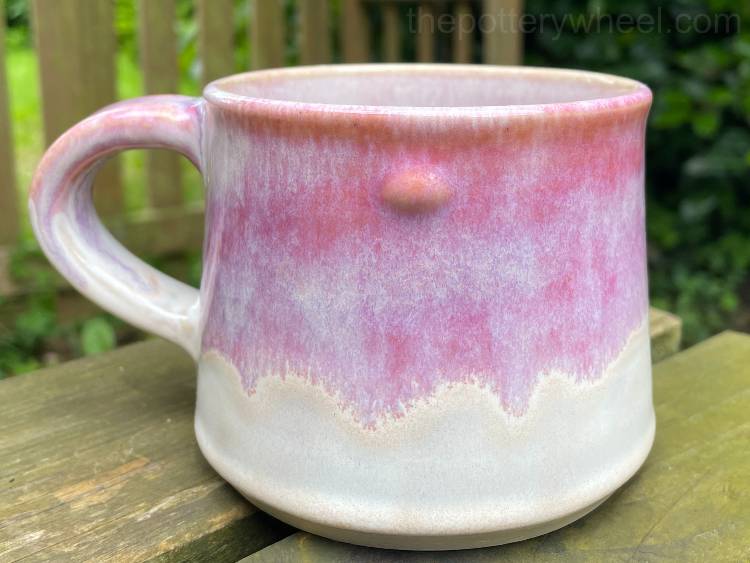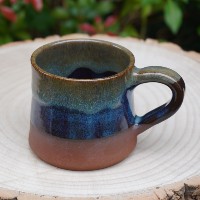Your cart is currently empty!
Bloating in Pottery Clay – 5 Reasons Clay Bloats
Published:
Last Updated:

Affiliate Disclaimer
As an affiliate, we may earn a commission from qualifying purchases. We get commissions for purchases made through links on this website from Amazon and other third parties.
Recently I had some of my pottery come out of the glaze fire with bloating in the clay. So, I went on a fact-finding mission to identify the cause and find a solution to this defect. I’m happy to say I’ve managed to fix the problem and I wanted to share what I’d learned about bloating in pottery clay.
What Does Bloating Look Like?
Bloating is a bubble that forms in the clay body and looks like a large blister or pocket of air trapped under the glaze. However, bloating is different from a regular blister.
Blisters in glaze are more superficial and happen just below the surface of the pottery glaze. By contrast, bloating is a pocket of air that happens within the clay body itself. It can look something like this…

Bloats in clay can vary in size. The bloating that formed in my pots were about the size of a blueberry or a raisin.
What Causes Bloating in Pottery Clay?
When clay is fired, many particles in the clay either burn away or decompose in the heat of the kiln. This creates gases in the body which can escape through pores in the clay, and through the glaze when it is still in its molten liquid state.
However, during firing, the clay and glaze form an intermingled layer called the body glaze layer. In the later stages of a firing schedule, this layer will begin to stiffen and become impermeable.
If this happens before all the gases have escaped, they can get trapped in the clay body. The clay itself is still soft and as the gas expands the clay balloons up to make room for the trapped gas. This is what causes the bubble in the wall of the clay.
There are a few reasons why gases can get trapped in this way. Here are some of the key ones…
1) The Bisque Fire
Most carbons in pottery clay are burned out during the bisque fire. However, this process takes time, and if the bisque fire is too quick or not hot enough, some of the carbons will remain in the bisqueware.
When the pot is then glaze fired, the glaze can start to seal over before the carbons have burned away. Once the clay glaze layer stiffens, the carbons can’t oxidize because they don’t have access to oxygen.
As a result, they draw oxygen from the iron oxide in the clay. This lowers the iron oxide in the clay, which causes the clay to become overly soft. Hamer and Hamer call this “over-vitrification” (p 29). The carbon oxides expand and cause the soft clay to bloat.
Solution
Slow down the bisque fire, and give the impurities in the clay a chance to burn out more completely.
You can also experiment by adding a hold time into the bisque fire at around 1500F (815C). Many of the gases that need to escape from the clay do so between 1500-1800F (815-982C). Holding the kiln at this temperature for a dwell can provide time for this off-gassing to occur.
It may also be worth experimenting with bisque firing your pottery to cone 04 rather than 06. You can read more about what temperature to bisque fire your pottery to here. But in short, bisque firing your pottery at a slightly higher temperature may help eliminate bloating in the clay at the later glaze fire stage.
2) Oxygen in The Kiln
Organic materials need oxygen to burn. There needs to be enough air in the kiln during the bisque fire to enable this process. If the kiln doesn’t have enough airflow, elements like sulfur and other organic matter don’t burn away sufficiently.
Solution
Keep one of the peepholes on your kiln open during the bisque fire. You can read more about the peepholes on your kiln here. Alternatively, you can invest in a venting system for your kiln. Vents bring fresh air into the kiln and get rid of gases that come from decomposition (source).
3) The Clay Body
Different types of clay are more likely to bloat than others. Earthenware clay, fired at earthenware temperatures usually doesn’t bloat. That’s because at low fire temperatures, the clay is still porous and the gases can escape.
Bloating is more likely to occur in mid to high-fire clay bodies. And whilst smooth white or light clay bodies are less prone to bloating, they can bloat if they are pushed to their limits.
Other clay bodies are more vulnerable to this problem. Some clays that have a reputation for bloating are:
- Speckled clays that contain granules of manganese to create flecks.
- Darker clays that have a high iron content.
- Clay that contains fire clay.
Solution
This depends on the type of clay you are using. Sometimes the solution is to bisque fire slowly to cone 04 to burn out as many impurities as possible.
At other times the solution is to make sure you are glaze firing at the right temperature. Some clay bodies are more prone to bloating the closer they get to being vitrified. A good idea is to reach out to the clay manufacturer and get some specific advice about the particular clay body you are using.
Regardless of the type of clay body in question, most types of clay will bloat if they are overfired. So, let’s take a look at the problem of overfiring now.
4) Over Firing
If clay and glaze are fired at too hot a temperature or for too long, they can be over-fired.
Being over-fired means that they have been exposed to too much heat work. When clay is over-fired, it can become brittle and either shatter or melt. Another common problem with over-fired clay is bloating.
Bloating occurs in overfired clay because when the clay has reached the point of being vitrified, gases can’t escape from the clay. The more heat work the clay gets, the more the materials in the clay decompose and create gasses. These gases put pressure on the fragile clay body and cause the clay to distort in shape.
Solution
Use cones when you are firing your pottery to make sure that it isn’t being overfired. I have a Skutt kiln with pre-programmed firing schedules. These are called the cone fire schedules. By using putting cone packs on each shelf in the kiln, I found that the pre-programmed cone 6 schedule was firing to cone 7.
Experiment With Glaze Firing Schedules
I wanted to find a cone 6 firing schedule that would help put an end to the bloating problem. So, I did some research and experimented with a few different firing schedules.
I found that what made a difference was making sure that the last 200F (100C) of the firing schedule was relatively slow.
I’ve tried a few cone 6 firing schedules, but this is the one that seems to work well in getting rid of bloating in my pottery clay.
| Rate | Target | Hold |
| 100C | 600C | 0 |
| 150C | 1122C | 0 |
| 60C | 1222C | 5 minutes |
| Rate | Target | Hold |
| 212F | 1112F | 0 |
| 302F | 2052F | 0 |
| 140F | 2232F | 5 minutes |
You may need to experiment with glaze firing schedules too. The simple schedule above works well with the clay bodies that I use. But all clays are different, and you may need to do your own research to find one that works for your clay too.
Controlled Cool Down
My pottery supplier also recommended that I try experimenting with a controlled cool down on the glaze fire. Rather than reaching the target temperature and allowing the kiln to switch off immediately, you can program in a final segment so that the kiln cools down at a slower rate. He suggested that this would help with the bloating problem.
My supplier recommended adding a final segment to the schedule so that the kiln cooled at a rate of 150F (65C) an hour until the kiln was at 1472F (800C).
I experimented with a few schedules that used a controlled cool-down. I found that I got less bloating with these schedules. However, I still got some small bloats and a few of my glazes didn’t look very good when a controlled cool-down was used.

Visit The Pottery Wheel Store
Fancy treating yourself to some homemade pottery? Looking for a unique gift? Check out my handmade pottery store…
5) Using Reclaimed Clay
I’m a big fan of using reclaimed clay. It saves money and it’s also better for the environment. By using reclaimed clay, you aren’t romping through the earth’s resources at such a fast pace.
However, using reclaimed clay does increase the chances of getting bloating in your pottery. There are a couple of reasons for this. They are:
Reclaimed clay is more likely to have air bubbles in it. If you don’t wedge the clay sufficiently, small air bubbles in the clay can expand during the glaze fire and cause the clay to bloat.
Recycled clay is more likely to contain debris and contaminants that can create problems. One example, of a contaminant is small bits of plaster if you reclaim and wedge on plaster boards.
Crystals of flux oxides can form in reclaimed clay. This is more likely to happen if the clay has been recycled a few times. When the clay is fired, the crystals can cause bloating.
Solution
Wedge reclaimed clay well. I now tend to use a combination of wedging techniques with reclaimed clay.
I start of spiral wedging it when it’s in a bigger quantity. Then I stack and slam wedge it until I can’t see any bubbles when I slice through it. Finally, once I’ve cut the clay into the portions I need to throw with, I rams head wedge each ball.
Also, in the past, I have used reclaimed clay again and again until it had all been used up. However, now, once I feel that the clay is past its best, I tend to get rid of it.
I can usually tell if it’s a bit tired when it starts to get short and crumbly when I bend the clay. Or if the clay gets very soft and floppy when I’m throwing. This usually starts happening after it has been recycled three or four times.
Final Thoughts
Bloating in pottery clay happens for a range of reasons. After a bit of research and experimentation, I concluded that my clay was probably bloating because it had been reclaimed.
My understanding is that you might get away with the odd air bubble in pots made of fresh clay. However, once the clay has been recycled repeatedly, the clay body has a different balance of ingredients and may have clusters of flux oxide crystals in it.
As a result, any tiny air bubbles cause bloating, and the bloating in the pottery clay becomes more apparent the higher the temperature of the kiln.
I managed to get on top of the problem by adjusting the firing schedule so that the kiln was firing at cone 6 rather than above. And by slowing the firing schedule down in the last segment.
I also now throw away recycled clay after it has been reclaimed more than a handful of times. It pains me to throw away clay, but it’s even more painful to open the kiln and find my pottery has bloated. So, it’s the right thing to do as the bloating issue has all but gone.
2 responses to “Bloating in Pottery Clay – 5 Reasons Clay Bloats”
-
You can refresh your reclaimed clay by adding ball clay. The fine particles of ball clay get washed away while throwing as evidenced in your throwing water. Thus plasticity goes away. Also helps by wedging in the ball clay while the recycled is still very wet. Let it sit sealed for a month to “mature”. Back in the ‘60s we’d add a can of beer when mixing a new batch to aid in aging. Supposedly that coerced the bacterial action to assist in making the clay more plastic. Maybe that’s a myth but we did it anyway.
-
Hi Cal, thanks for your suggestion. I’m going to give that a go too.
-




Leave a Reply